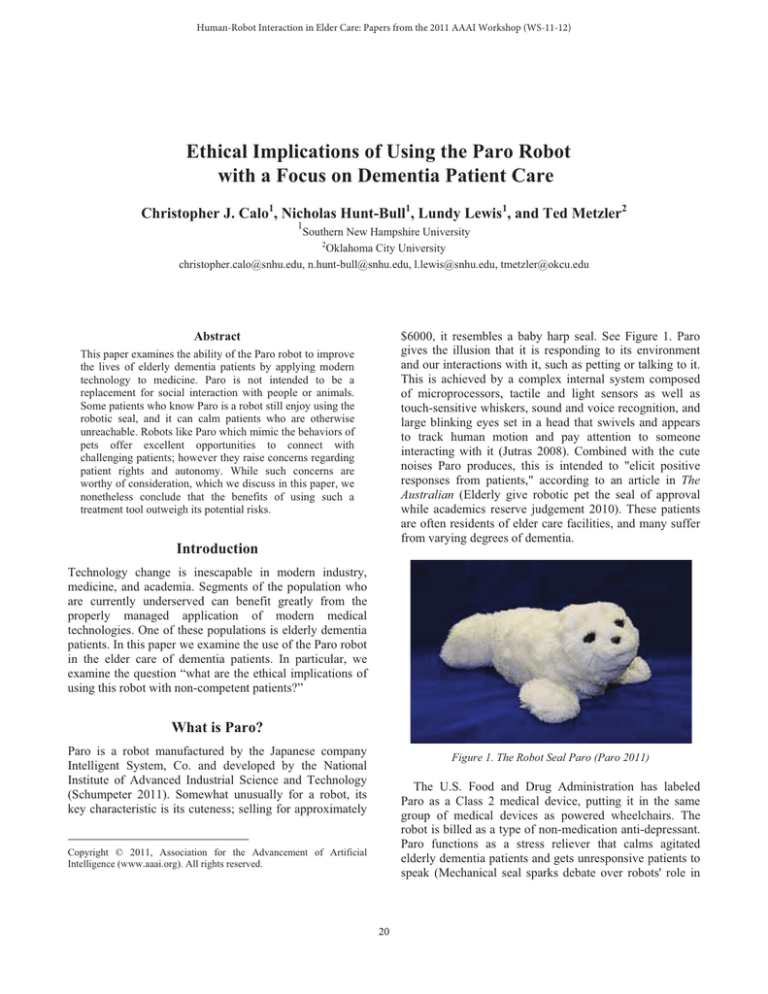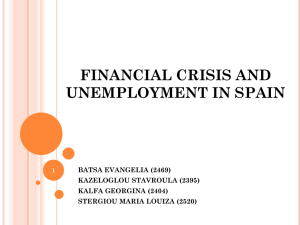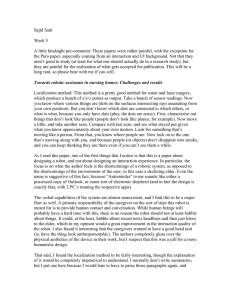Ethical Implications of Using the Paro Robot Christopher J. Calo
advertisement

Human-Robot Interaction in Elder Care: Papers from the 2011 AAAI Workshop (WS-11-12) Ethical Implications of Using the Paro Robot with a Focus on Dementia Patient Care Christopher J. Calo1, Nicholas Hunt-Bull1, Lundy Lewis1, and Ted Metzler2 1 Southern New Hampshire University 2 Oklahoma City University christopher.calo@snhu.edu, n.hunt-bull@snhu.edu, l.lewis@snhu.edu, tmetzler@okcu.edu $6000, it resembles a baby harp seal. See Figure 1. Paro gives the illusion that it is responding to its environment and our interactions with it, such as petting or talking to it. This is achieved by a complex internal system composed of microprocessors, tactile and light sensors as well as touch-sensitive whiskers, sound and voice recognition, and large blinking eyes set in a head that swivels and appears to track human motion and pay attention to someone interacting with it (Jutras 2008). Combined with the cute noises Paro produces, this is intended to "elicit positive responses from patients," according to an article in The Australian (Elderly give robotic pet the seal of approval while academics reserve judgement 2010). These patients are often residents of elder care facilities, and many suffer from varying degrees of dementia. Abstract This paper examines the ability of the Paro robot to improve the lives of elderly dementia patients by applying modern technology to medicine. Paro is not intended to be a replacement for social interaction with people or animals. Some patients who know Paro is a robot still enjoy using the robotic seal, and it can calm patients who are otherwise unreachable. Robots like Paro which mimic the behaviors of pets offer excellent opportunities to connect with challenging patients; however they raise concerns regarding patient rights and autonomy. While such concerns are worthy of consideration, which we discuss in this paper, we nonetheless conclude that the benefits of using such a treatment tool outweigh its potential risks. Introduction Technology change is inescapable in modern industry, medicine, and academia. Segments of the population who are currently underserved can benefit greatly from the properly managed application of modern medical technologies. One of these populations is elderly dementia patients. In this paper we examine the use of the Paro robot in the elder care of dementia patients. In particular, we examine the question “what are the ethical implications of using this robot with non-competent patients?” What is Paro? Paro is a robot manufactured by the Japanese company Intelligent System, Co. and developed by the National Institute of Advanced Industrial Science and Technology (Schumpeter 2011). Somewhat unusually for a robot, its key characteristic is its cuteness; selling for approximately Figure 1. The Robot Seal Paro (Paro 2011) The U.S. Food and Drug Administration has labeled Paro as a Class 2 medical device, putting it in the same group of medical devices as powered wheelchairs. The robot is billed as a type of non-medication anti-depressant. Paro functions as a stress reliever that calms agitated elderly dementia patients and gets unresponsive patients to speak (Mechanical seal sparks debate over robots' role in Copyright © 2011, Association for the Advancement of Artificial Intelligence (www.aaai.org). All rights reserved. 20 eldercare 2010). It is not designed to be a replacement for human or animal contact but a facilitator of it. Patients are meant to use it in a group setting to decrease social stress, not play with it in isolation or as a replacement of interacting with people and animals (Tergesen and Inada 2010). non-sophisticated nature of Paro. These robots are not programmed to think and adapt in the sophisticated way that humans and some animals do. They “learn” in very limited ways, according to pre-designed algorithms. They respond in pre-programmed ways, with little room for onthe-fly decision making. They are clearly not themselves moral agents, as some of the authors of this paper consider more sophisticated forms of artificial intelligence (AI) to be. Therefore, questions about the morality of Paro’s creation and use fall within the normal moral discussion of most man-made objects and, unlike some discussions about robots, are really questions about the consequences of using Paro and/or the intentions of the creators and users of this product. According to the Paro website, the Paro robot “allows the documented benefits of animal therapy to be administered to patients in environments such as hospitals and extended care facilities where live animals present treatment or logistical difficulties” (http://www.parorobots.com). This allows elder care facilities to reap the benefits of animal therapy without the problems associated with live animals. As already noted, Paro cannot bite patients, its antiseptic coat will not shed dander, and it does not eat food or create waste. A patient who is challenged caring for herself may want a pet, but care of a living animal is a significant burden. This is avoided if they are using Paro (Harmon 2010b). One can reasonably ask whether it is even true that Paro provides the benefits of animal therapy. Bill Thomas, professor of aging at the Erickson School at the University of Maryland, Baltimore County, commented on National Public Radio that “One of the things that we’ve learned is that it is the unexpected and spontaneous behavior of the living creature that adds so much of the value to people’s experience” (Greenfieldboyce 2008). Thomas argues that the exclusion of pets, and plants, from most nursing homes is a choice and not a matter of necessity at all. Thomas suggests that for most inmates in a nursing home, “a fur covered robot…doesn’t solve the problem that is really causing their distress and their lack of enjoyment in life” (Greenfieldboyce 2008). While Thomas may be correct in his analysis of the deeper issues with the institutionalization of the elderly, or he may not, let us put this more general issue aside for now, and ask whether, if Paro works, it is a good idea to replace a living creature with a robot? This is obviously not a simple question to answer, and we suspect that at core the search for an answer needs to address two deep intuitive responses which people have when they see Paro.2 The two intuitive responses are: 1) “oh this is so cute!” and 2) “wow, there is something deeply creepy about this.” These two intuitions come together in the battery re-charging device for the Why is Paro Used? Interactions between Paro and humans are clearly intended to mimic not actual interactions with a seal, but rather a common human fantasy about what interacting with a baby seal would be like. Humans have commonly assumed that since the seals look like soft, silky, white teddy bears, they must be adorable and cuddly.1 Thus, the Paro has been designed to act like this fantasy projection of a seal, and not that much like real baby harp seals. In the New York Times the inventor of the Paro explained that the design team intentionally chose an unfamiliar animal because if had they used a familiar one customers would have noticed that the robot failed to perfectly imitate the actual motions of the animal. “Because the technology was not sophisticated enough to conjure any animal accurately, [we] chose one that was unfamiliar, but still lovable enough that people could project their imaginations onto it. ‘People think of Paro,’ [Dr. Shibata] said, ‘as ‘like living.’”’. (Harmon 2010b) Paro is thus like a puppy or a kitten, but its fur is hypoallergenic, it does not shed or scratch, and one does not need to feed it or clean up after it. Patients (and nursing home staff!) respond to the robot seal’s conformity to their conceptions of what a cuddly critter should do. The robot responds positively to gentle touches and nice words, and patients are drawn to it. Keep in mind that patients in a nursing home need much more than mere basic medical care and food—as we all know, they often need social or psychological assistance or merely help to find life more stimulating. It seems that most people perceive the robot as an animate object and treat it as though it is alive and needs loving attention. This process, which has documented positive effects on patient behavior and health, is referred to by Shidata and others as “robot therapy” (Harmon 2010). Paro’s animal sounds, apparent expressions of emotion, and ability to learn the voices of repeat users can evoke therapeutic, emotional responses from patients. For these reasons, Paro is considered “socially assistive” (Slomski 2009). The Ethics of Using Paro When we enter the discussion of human-robot interaction concerning the robotic seal, we need to note the relatively 2 Watching a video of the device is likely to produce these effects in a reader—alternatively one can read comments posted online by others who have watched such videos to find support for the claims in this paragraph. 1 Of course, real bears are quite vicious too, so perhaps the analogy is fitting and not ironic. 21 Paro, which plugs into the baby seal’s mouth, and is shaped just like a soother one would give a nursing human baby. What could be more kawaii than a charger shaped like a soothie! The Paro is such an extreme object of projected human desires, of the very Japanese concept of “cute” made manifest, that its manipulativeness seems at times too much to bear. manipulative. Sometimes we just choose to deceive ourselves about the true emotional nature of objects. For those of us who are fully or mostly competent, if we choose to believe that our computer has a personality and crashes at the worst possible times because it hates us (as Nicholas’s Dell laptop hates him) that is our choice. This is an innocent delusion, perhaps like reading the horoscope in the newspaper. We know it is fake, but we can pretend to think differently. We choose to suspend rationality and belief. A widely discussed example of successful use of Paro with dementia patients is that of Millie Lesek, another resident at Vincentian Home. She was calmed by the robot seal and perceived it to love her—an emotion which she actively reciprocated (Barcousky 2010). See Figure 2 for an image of Mrs. Lesek interacting with Paro. Mrs. Leskek’s daughter has described in detail how much use of the tool helped her mother’s last months of life, describing how she communicated with her mother by playing with Paro together (Harmon 2010a). Let us assume that Millie Lesek did not known that Paro was a robot, and fully believed it to be a pet seal that somehow had come to live with her. The seal fell asleep every two hours when the charge ran down, but that did not bother her. Self-Deception Using Paro Paro is a powerful tool of emotional seduction. Some patients who clearly know Paro is a robot opt to take turns petting the robotic seal. Writing in The New York Times, Amy Harmon quotes patient Pierre Carter of the Pittsburg Vincentian Home, “I know that this isn’t an animal… But it brings out natural feelings” (Harmon, 2010b). He even calls the robot “Fluffy.” Another patient in the same facility said to Paro itself, that she knows it is not real but still loves it (Tergesen and Inada 2010). The staff at that facility say that they tend to walk through the halls talking to Paro as though it were a living being. They play with the robot themselves, as did many visitors to the huge Consumer Electronics Show in Las Vegas. These tech sophisticates coo like children at the petting zoo in videos easily accessible on the web. If Paro is so desirable for people who are highly functioning, it is hardly surprising that dementia sufferers find the robot appealing as well. It is so cute! Consider what is going on when we love a pet. Rover may love us back or not, but what we feel is a genuine human emotion. This involves commitment and risk. It is “the real thing.” The pet has enough choice, enough “spontaneity” in Thomas’s terms, to decide to love us or not. Paro the robot is just a thing. And yet people clearly feel similar emotions towards their Paro pets—and we must consider whether this is problematic or not. Many of us fully in control of our faculties personify objects in our lives—like cars or computers—all the time. We talk to them as if they were thinking and feeling things that could care about us. Supporters of the Paro note that patients who use Paro are aware that it is not a real animal, and that even skeptical patients can be moved by the robot’s emotionally evocative actions (Harmon 2010b). If this is true, then there is nothing special about Paro. At first blush, this does not seem enough of a defense. For one thing, many of the patients using Paro are suffering from moderate to advanced dementia. Others who are fully mentally aware, inhabit a social environment so dull that any stimulation would be engrossing. Thus, even though the intention of the tool is therapeutic, it appears that Paro will often be emotionally manipulative. Dementia patients presumably do not realize that Paro (renamed Fluffy or Bruce presumably) is not real. Yet, so what? We are not convinced that there is anything special about Paro, or its being a robot, that makes it deceptive or Figure 2. Mrs. Lesek Interacting with Paro (Barcousky 2010). It seems churlish to deny that Paro is an effective tool. Mrs. Lesek has few enough pleasures left and little time. Much more joy is produced by the actual delusion of her thinking Paro a real seal—but this produces great good, and at this point we note she possessed no functioning autonomy to violate. Robots Replacing People? Paro was certainly not designed to be a replacement for social interaction with people. As mentioned previously, Paro’s purpose is to grease the gears of social interaction. Yet, any time we replace something alive with a robot, it raises the question of what we will or might lose in human 22 interaction. If a Paro robot is used by a facility whose personnel do not properly regulate usage, or who let patients use Paro in isolation instead of in groups or as part of other activities, then Paro use could become detrimental (Barcousky 2010). In contrast, if the robot seal is used to encourage communication amongst individuals who have a common interest in the robot (or love for it)—which it appears to reciprocate—then it can play a role in improving their quality of life. Angry patients who are unwilling to interact with other residents can be calmed by interacting with Paro as well. According to Tergesen and Inada, writing in The Wall Street Journal, agitated and aggressive dementia patients can be successfully calmed by holding Paro. They describe watching one such patient switching from angry outburst to professions of love after holding the robot (Tergesen and Inada 2010). See Figure 3. If the presence of a baby seal robot can calm patients and lessen the risk of physical or emotional harm, it clearly has potential as a therapeutic aid. Moreover, since it can calm patients it can in some cases reduce or replace the need for medications and other more invasive or dangerous interventions (Meet the human face of robots 2011). dimension of assessment – viz., the ways in which substituting HRI for HHI can change people. Fairly promptly in her book, Turkle reminds the reader “We make our technologies, and they, in turn, shape us” (19). In particular, she observes that the book “is about how we are changed as technology offers us substitutes for connecting with each other face-to-face” (11). Turkle’s concern with ways in which substituting HRI for HHI can change people yields interesting contrasts with our preceding discussion of the case involving Mrs. Lesek and Paro. Consider, for example, her reflections on HRI between Paro and an elderly woman named Miriam: I think back to Miriam, the seventy-two-year-old woman who found comfort when she confided in her Paro. Paro took care of Miriam’s desire to tell her story – it made a space for that story to be told – but it did not care about her or her story. This is a new kind of relationship, sanctioned by a new language of care. Although the robot had understood nothing, Miriam settled for what she had. And, more, she was supported by nurses and attendants happy for her to pour her heart out to a machine. To say that Miriam was having a conversation with Paro, as these people do, is to forget what it is to have a conversation. The very fact that we now design and manufacture robot companions for the elderly marks a turning point. We ask technology to perform what used to be “love’s labor”: taking care of each other. (106107) To be sure, the case of Miriam might have presented violations of precisely the intended uses for Paro that we have mentioned (e.g., using it “in a group setting” and not interacting with it “in isolation”). On the other hand, it also appears to be part of Turkle’s skeptical stance that she fears such violations are likely to become common. She describes, for instance, another case of a son named Tim who, in the process of visiting his mother at a nursing home, has formed an approving opinion of Paro. Turkle notes that Tim “said it [i.e., Paro] made ‘walk[ing] out that door’ so much easier when he visited her” (124), adding the following list of thoughtful questions: In the short term, Tim’s case may look as though it charts a positive development. An older person seems content; a child feels less guilty. But in the long term, do we really want to make it easier for children to leave their parents? Does the “feelgood moment” provided by the robot deceive people into feeling less need to visit? Does it deceive the elderly into feeling less alone as they chat with robots about things they once would have talked through with their children? If you practice sharing “feelings” with robot “creatures,” you become accustomed to the reduced “emotional” range that machines can offer. As we learn to get the “most” out of robots, we may Figure 3. Patient Interacting with Paro and Paro Responding (Harmon 2010 July 4). Robots Changing People? Although Paro was not designed as a replacement for social interaction with people, one still might observe that, during actual occasions when it becomes the focus of attention for elder humans, it often may be substituting human-robot interaction (HRI) for human-human interaction (HHI) or human-cuddly pet interaction. This observation, in turn, recommends consideration of MIT Professor Sherry Turkle’s recent book, Alone Together: Why We Expect More from Technology and Less from Each Other. Alone Together is richly relevant to our present discussion. It not only includes critical commentaries specifically involving the Paro robot (and numerous similar artifacts that psychologist Sherry Turkle has studied for decades), but it also highlights an additional 23 lower our expectations of all relationships, including those with people. In the process, we betray ourselves. (125) Indeed, we already have acknowledged that improperly regulated usage of the Paro robot could become detrimental, and that consequences of its use could raise moral questions. Questioning whether the message of Alone Together represents a direct challenge to our conclusions, though, seems to involve deep philosophical issues that cannot be expected to reach resolution within the scope of this essay. Most notably, perhaps, at least some of the co-authors of the present paper may hold an understanding of personhood that is fundamentally different from that of Professor Turkle. The difference shows up especially when we compare assessments of the long-term prospect of robotic artifacts attaining kinds of capabilities compatible with regarding them as bona fide moral agents. The authors of this paper already have claimed that robots of the class to which Paro belongs are “clearly not themselves moral agents,” although some of us are open to the possibility of that status being attained by “more sophisticated forms of artificial intelligence.” Turkle obviously shares our negative judgment of simple animaloids such as Paro clearing the bar for moral agency. She is acquainted, though, with more advanced forms of AI and robotics as well; her office in the MIT Artificial Intelligence Laboratory was provided by roboticist Rodney Brooks, facilitating her work, for example, with Cynthia Breazeal and Brian Scassellati in exploring HRI between children and the Kismet and Cog robots (xv). Nonetheless, Turkle refers at one point to theologian Martin Buber’s celebrated ‘I – Thou’ relation, observing that it “implies a symmetrical encounter,” but adding “There is no such symmetry between human beings and even the most advanced robots” (85). Tacitly categorizing HHI and HRI as kinds of relations that are parallel, respectively, with Buber’s ‘I – Thou’ and ‘I – It’ strongly suggests that Professor Turkle’s underlying weltanschauung for Alone Together may be, in Kuhnian idiom, incommensurable with metaphysical presuppositions accepted by many of her MIT colleagues – and probably with those held among some of the authors of the present essay. Nevertheless, we share recognition of the importance and relevance of Sherry Turkle’s research, making it appropriate to acknowledge the (often different) treatment of our subject that one finds in Alone Together. and lessen the need for medication. One would hope that Paro is never used as a substitute for human contact; with this caveat it is clearly a valuable resource. It is important to consider the implications of deceiving dementia patients with a robot that simulates life. If a decision is made to willfully deceive a dementia patient for his or her benefit, the justification for such deception must be thought through, and the gains for the patient must outweigh significantly any possible costs to him or her. Robots like Paro offer excellent opportunities to connect with individuals who appear otherwise unreachable. When animal therapy is indicated, and the use of real animals is inappropriate due to allergies, logistics, living situations, or a person's inability to care for them, then a fake animal provides a low-risk alternative. While not without some interesting challenges, we see no reasons to reject the use of tools such as Paro. References Barcousky, L. 2010. PARO Pals; Japanese robot has brought out the best in elderly with Alzheimer's Disease. Pittsburgh PostGazette. 2010. Elderly give robotic pet the seal of approval while academics reserve judgement. The Australian: 33. Harmon, A. 2010a. Discovering a Soft Spot for Circuitry. Retreived April 19, 2011, from NYTimes.com: http://www.nytimes.com/2010/07/05/science/05robot.html. Harmon, A. 2010b. SMARTER THAN YOU THINK; Circuitry With a Feel for Humanity. The New York Times. Jutras, L. 2008. Cuddling with roboseal: therapy with a dash of creepy. The Globe and Mail (Canada). Mechanical seal sparks debate over robots' role in eldercare. 2010. McKnight's Long-Term Care News & Assisted Living. Meet the human face of robots. 2011. Meet the human face of robots. Canberra Times:13. Paro. 2011. Retreived April 24, 2011: http://www.parorobots.com/. Schumpeter, J. 2011. I, robot-manager. The Economist. Slomski, A. 2009. Robots can already perform surgery and track your meds. Now, new models aim to provide therapy and support. The Washington Post. Tergensen, A.; and Inada, M. 2011. It's Not a Stuffed Animal, It's a $6,000 Medical Device - Paro the Robo-Seal Aims to Comfort Elderly, but Is It Ethical?. The Wall Street Journal. Turkle, S. 2011. Alone Together: Why We Expect More From Technology and Less from Each Other. New York: Basic Books. Conclusion Paro has an ability to calm agitated elderly dementia patients. It can relieve their stress, make them feel loved, facilitate communications between peers and loved ones, 24




